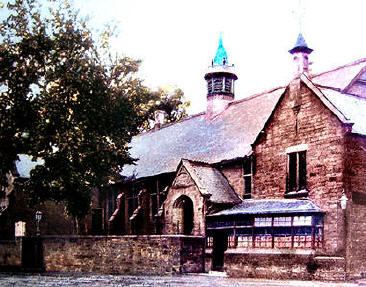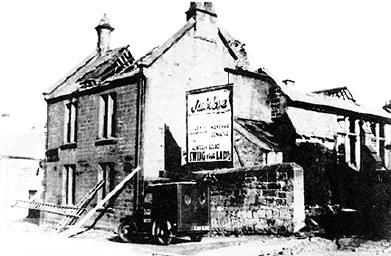|
Jubilee Hall |
|
The
Mechanics' Institute was established in 1850 by the Rev. G.C.V Harcourt,
the Rector of Rothbury who presented 295 volumes of 'good, sound
literature', and continued thereafter
to increase the number of books till his death in 1870. premises consisted of a small reading room situated at the
end of the Black Bull long room, but in 1864 a new library room was built by
voluntary subscription; Mr. R
At this time provision was also made to house the local hearse and the Rothbury fire engine (circa 1788) on the ground floor.This had been presented to the village in 1788 by Robert Farquar after a disastrous fire which destroyed a large number of thatched houses. This is recorded on a piece of parchment pasted into the Vestry Book dated 1785, duly signed by George Farquar and witnessed by Thos Adams, Solicitor of Alnwick and is translated from the Latin as : " August 1788, George Farquhar Esq., presented to the town and parish of Rothbury, in the county of Northumberland, a fire engine, under the care and control of the Rector and Churchwardens for the time being, of the same parish, for ever." Shortly after this a vestry meeting was held on 10th Aug 1788 when it was "agreed also to allow John Storey, of Rothbury, one guinea for the care of the fire engine per annum and signed by the Rector, Rev Drummond" Although later transferred to the Jubilee Hall it was originally stored in the Church porch under the charge of John Watson the sexton.. Now restored to full working order it is now housed the Bailliewick museum in Alnwick, having had a short holiday in the erstwhile garage at Town Foot . A great shame but at least it will be on public display and well cared for. In 1873 there was a substantial rise in the population of Rothbury, mainly due to the number of people who had taken up regular employment in the grounds at Cragside, and the committee considered the advisability of extending the library by adding a reading room. This was carried out under the direction of the Rector Dr. Ainger and proved extremely popular. But the library did not rest on its laurels and in 1888 there was another addition; that of a lecture hall and recreation room as a permanent commemoration of the Queen's Jubilee. Generous donations were given by locals including Lord Armstrong, whilst the site itself was a gift of the Duke of Northumberland. An interesting point here is that in the event of the hall being sold, it must be offered in the first instance to the current Duke of Northumberland for £200. However in 2009 when a new governing body was was established this was changed so that in the event that it ceases to be viable the Duke has the right to buy it at market valuation. The opening ceremony on 7th September 1888 was chaired by Lord Armstrong, speeches given by Thomas Hodgkin, Colonel Watson and The Rev Medd, whilst the hall was 'declared open' by Lady Armstrong. A short time later The Newcastle Journal dated 12th February 1889 reported: The recreation room - a large apartment on the ground floor beneath the library room where the members can smoke and chat and enjoy themselves in playing various games - was opened for the first time on Friday night last (8 February) and in future on Sunday afternoon the rooms will be open to members from l pm to 5.45pm and from 8pm until lOpm (sic). This, it is expected, will supply a want long felt by Rothbury workmen- particularly those who are at lodgings - and it is hoped that many will avail themselves of the use of these comfortably fitted up rooms where they can spend a quiet hour on a Sunday afternoon in the acquirement of useful knowledge. The Jubilee
Hall
has had a chequered history, including being burnt
down in July 1939 following Saturday evening pictures.
There was no
The old fire engine had been provided in 1788 by Robert Farquar after a disastrous fire which destroyed a large number of thatched houses. Although later transferred to the Jubilee Hall it was originally stored in the Church porch. Now restored to full working order it is back in Rothbury and housed in the garage at Town Foot. However there is a rumour that it is soon to be moved to the Bailliewick museum in Alnwick. A great shame but at least it will be on public display and well cared for. Certainly a public meeting had been held in 1885 to discuss its replacement; described in the newspaper as 'wretched old squirt which stands beside the parish hearse'. What an epitaph for so dignified a machine! In 1944 during World War II the hall was rebuilt at the army's request as a centre for the troops and changed considerably. It no longer boasted the reading room and the roof was entirely different. But the pictures were revived and for many years the hall echoed to the sound of, now, almost forgotten stars. The twice nightly (saving Sunday) pictures attracted farmhands from miles away, and with the soldiers billeted in the village, queues up to a hundred yards long would snake through the village awaiting the second 'house'. The News was always old, and visitors on holiday were treated to a rerun of Pathe News, already seen in towns a fortnight earlier. The pictures finished in 1960 and the last film shown was The Ten Commandments. Over the years there were discussions regarding a complete re-vamp both inside and out. Plans were drawn up for a modern glassed in vestibule with a balcony in the main hall and a corridor underneath. But there were insufficient funds and the idea was dropped. The inside however was completely rebuilt and now boasts a number of function rooms as well as a computer section and youth Drop-In centre. The installation of sound and projection equipment revived the cinema and films are now shown every two weeks. The main hall hosts talks, concerts and shows as well as the ubiquitous coffee mornings that are a regular part of village life. Further down in the area called "Town Foot" stands the Queen's Head at the corner of Brewery Lane, the brewery itself now long gone and the hotel changed substantially over the years. The older
portion of the Queens Head was erected in 1790 and for the first fifty years of
its existence was known as the Golden Fleece. Jane Snowden was the hostess in
1827 and thereafter it was kept by the Dores family, followed by Mr.
Lawson who restored and enlarged the property. The change in name probably took
place in 1837 in commemoration of Queen Victoria's accession to the throne. In
1877 Mr. Temple rebuilt the old property next door which was then added to the
hotel and made a number of other changes to cater for the ever increasing trade Continue your walk towards the Garage at the east end of the village
|
 Farrage being the collector and treasurer of the
fund.
Farrage being the collector and treasurer of the
fund.  fire brigade in the village at that time and the nearest was in
Morpeth some 15 miles away. But nothing daunted, the old fire engine (circa. 1788) was brought out of retirement to extinguish the fire.
fire brigade in the village at that time and the nearest was in
Morpeth some 15 miles away. But nothing daunted, the old fire engine (circa. 1788) was brought out of retirement to extinguish the fire.